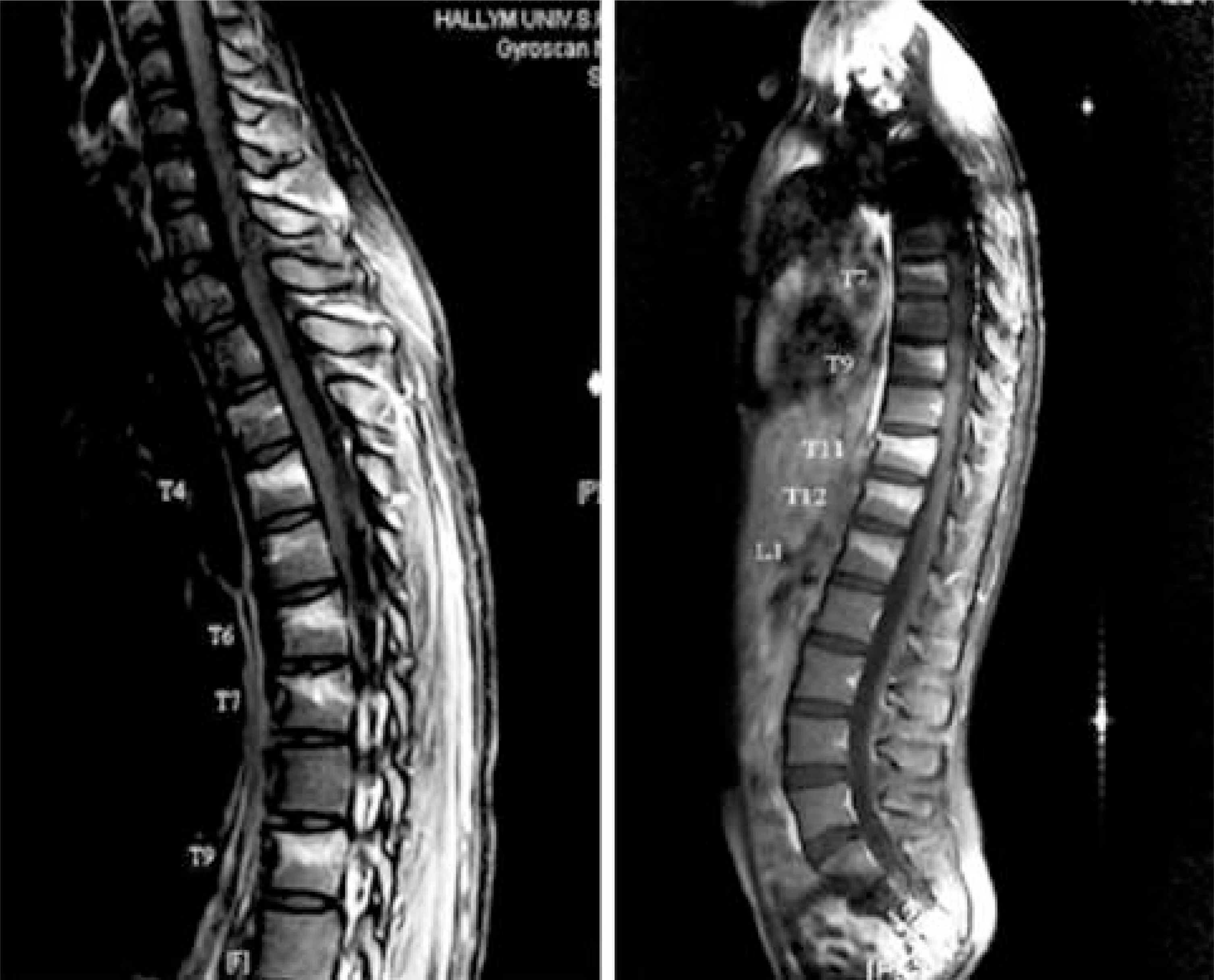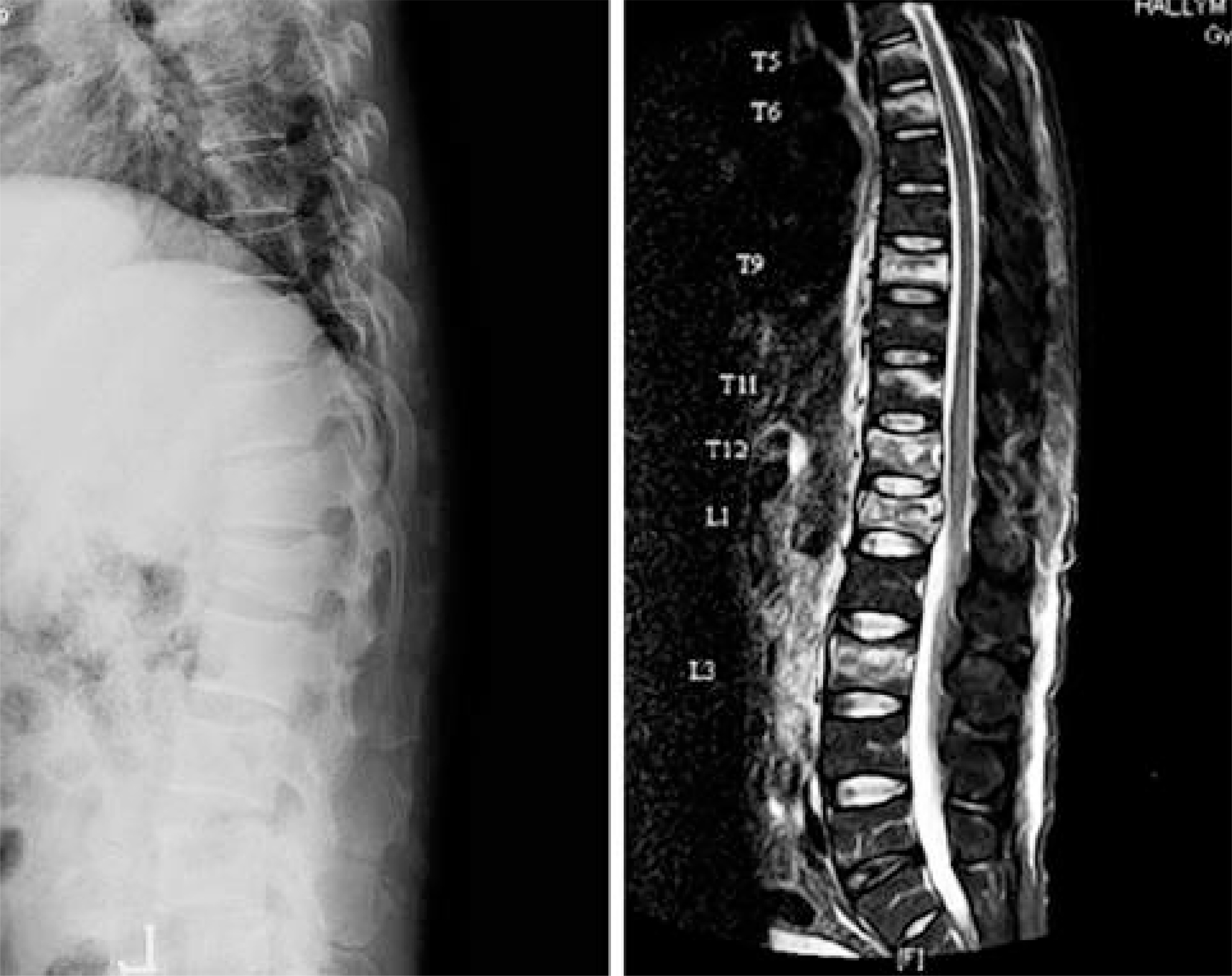J Korean Soc Spine Surg.
2005 Sep;12(3):206-213. 10.4184/jkss.2005.12.3.206.
Multiple Spine Fractures of Young Adult (Over 3 Vertebrae)
- Affiliations
-
- 1Department of Orthopedic Surgery, Hallym University Sacred Heart Hospital, College of Medicine, Hallym University Seoul, Korea. oskdj@hallym.or.kr
- KMID: 1941686
- DOI: http://doi.org/10.4184/jkss.2005.12.3.206
Abstract
- STUDY DESIGN: A retrospective study.
OBJECTIVES
To analyze the mode of injury, associated lesions, time of injury, and the checking times of MRI/CT and Bone scans in multiple spine fractures SUMMARY OF LITERATURE REVIEW: CT was predominantly used to discover and identify the fracture levels of the spine. However, fracture level identification in the entire spine was limited. CT, MRI and Bone scans were used for diagnosing multiple spine fractures.
MATERIALS AND METHODS
Between 1999 and 2004, 12 patients who had more than level 3 spine fractures were studied. The mode of injury, associated lesions, time of injury, and checking times of MRI/CT and Bone scans were analyzed.
RESULTS
The causes of the spinal injuries were from a fall from height, from traffic accidents and from multi-complex forced trauma in 7, 4 and 1 cases, respectively. Most cases had no severe associated lesions. The accuracy of the plain roentgenograms was 26% and that of CT was 35.3%, and the average checking time was 1.5 days. The accuracy of MRI was 100% and the average checking time was 4.3 days. The accuracy of the bone scans was 100%, and the average checking time was 11.7 days. The fracture patterns consisted of 37, 7, 3 and 3 non-compression (74%), compression (14%), burst (6%) and fracture-dislocation types (6%), respectively. The major treatment methods used with these patients were conservative. The treatment methods in 4 cases were with the use posterior instrumentation.
CONCLUSIONS
MRI produced more accurate and faster results than the other methods of detection. The accuracy of the plain roentgenograms was 26%, which was relatively inaccurate. Therefore, if the patient complains of multiple back pains, the surgeon must check other diagnostic tools.
Keyword
MeSH Terms
Figure
Cited by 1 articles
-
Multiple Non-contiguous Spine Fractures with Concomitant Injuries - A Case Report -
Soo Uk Chae, Yeung Jin Kim, Jung Hwan Yang, Ji Wan Lee, Jae In Park
J Korean Fract Soc. 2011;24(3):267-270. doi: 10.12671/jkfs.2011.24.3.267.
Reference
-
1). Korres DS, Katsaros A, Pantazopoulos T, Hartofi-lakidis-Garofalidis G. Double or multiple level fractures of the spine. Injury. 1981; 13:147–152.
Article2). Jorgensen RD, Joseph Jr. J. Multiple noncontiguous spine fractures at four levels in a neurologically intact patient. J Trauma. 1996; 41:750–753.
Article3). Acaroglu ER, Alanay A. Four-level noncontiguous fracture of the vertebral column: a case report. J Orthop Trauma. 2001; 15(4):294–9.4). Dai LY, Jia LS. Multiple noncontiguous injuries of the spine. Injury. 1996; 27:573–575.
Article5). Powell JN, Waddell JP, Tucker WS, Transfeldt EE. Multiple-level noncontiguous spinal fractures. J Trauma. 1989; 28:1146–1151.
Article6). Kosven AM. On complicated fractures of the spine. Ortop Traumatol Protez. 1965; 26:56–8.7). Griffith HB, Gleave JRW, Taylor RG. Changing patterns of fractures in the dorsal and lumbar spine. Br Med J. 1966; 1:891–894.8). Calenoff L, Chessare WJ, Rogers FL, et al. Mu lti ple level spinal injuries: Importance of early recognition. Am J Roentgenol. 1978; 130:665–669.9). Albert TJ, Levine MJ, An HS, et al. Concomitant noncontiguous thoracolumbar and sacral fractures. Spine. 1993; 18:1285–1291.
Article10). Bentley G, McSweeney T. Multiple spinal injuries. Br J Surg. 1968; 55:565–570.
Article11). Henderson LR, Reid CD, Saboe AL. Multiple noncontiguous spine fractures. Spine. 1991; 16:128–131.
Article12). Korres DS, Boscainos PJ, Papagelopoulos PJ, Psy-charis I, Goudelis G, Nikolopoulos. Multiple level noncontiguous fractures of the spine.Clin Orthop. 2003; 411:95–102.13). Anderson S, Biros MH, Reardon RF. Delayed diagnosis of thoracolumbar fractures in multiple-trauma patients. Acad Emerg Med. 1996; 3(9):832–9.
Article14). Shear P, Hugenholts H, Richard Mt, et al. Management of noncontiguous vertebral fractures. J Trauma. 1988; 28:655–9.15). Vaccaro AR, An HS, Lin S, et al. Noncontiguous injuries of the spine. J Spinal Disord. 1992; 5:320–9.
Article16). Thomas KC, Lalonde F, O'Neil J, Letts RM. Multiple-level thoracolumbar burst fractures in teenaged patients, J Ped Orthop. 2003; 23(1):119–23.
Article17). Wittenberg RH, Hargus S, Steffen R, Muhr G, Botel U. Noncontiguous unstable spine fractures. Spine. 2002; 1(27):(3):. 254–7.
- Full Text Links
- Actions
-
Cited
- CITED
-
- Close
- Share
- Similar articles
-
- Multiple Fractures in Thoracic Vertebrae after Epilepsy
- Incidental Diagnosis of Multiple Myeloma during Conservative Treatment for Vertebral Fracture
- Twelve Contiguous Spinous Process Fracture of Cervico-Thoracic Spine
- A Case of Multiple Osteoporotic Compression Fractures in Young Man with Budd-Chiari Syndrome
- A Case of Cushing Syndrome Diagnosed by Recurrent Pathologic Fractures in a Young Woman



